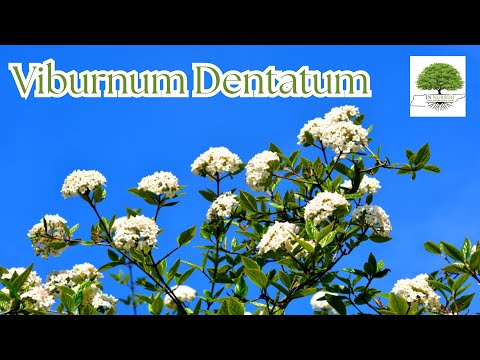Viburnum Dentatum for Sale
Viburnum dentatum is a deciduous shrub native to North America. It features attractive clusters of white flowers, vibrant blue-black berries, and toothed leaves, making it a versatile and popular choice for hedges and wildlife gardens.
It earned its name because the inhabitants of the areas where it grew used the branches to create arrows in past centuries. The deciduous shrub's straight branches made it an ideal choice for that purpose.

The Looks Of The Viburnum Dentatum
The shrubs produce small clusters of white flowers about 4 inches wide, which start appearing in the spring. They also produce small fruits as the summer progresses. Although they can expand as tall as 15 feet, they often stand under 10 feet in height. Their impressive size makes them a great shrub for hedgerows. Many people plant arrowwood shrubs individually in their yards or gardens. However, they are also popular choices to adorn the shores of creeks or ponds.
Viburnum Dentatum Arrowwood Has A Elegant Appearance
This rounded shrub has a graceful, elegant appearance. The branches and twigs have a grayish-brown color and are slender. With their ridges, they add a touch of rustic appeal. Greenish-brown buds create a contrast that commands attention. Its white flowers are delicate and look stunning against its colorful leaves. The toothed edges of the leaves give the plant its name. Although they start with a green hue, they gradually turn yellow and red as the seasons change. During the summer, the bluish-black fruits add even more beauty. For anyone who enjoys a colorful landscape, this type of shrub does not disappoint. Order your Viburnum Dentatum today.
It Is A Native Shrub That Attracts Wildlife
In addition to its aesthetic benefits, there may be health benefits for some. It is also an excellent choice for people who want to attract wildlife. Several songbirds enjoy the fruit, and some animals eat the twigs and leaves. Since the flowers have nectar, they are helpful to bees. butterflies are also attracted to the flowers. It is an excellent example of nature's profound beauty and ability to change. It is a great choice for anyone because of its ecological, aesthetic, and other potential benefits.
What is the common name for it?
Another name for it is Arrowwood. This is because native Americans used them to make arrows.
Can you grow them from cuttings?
Indeed, Viburnum Dentatum can be propagated from softwood cuttings taken during the early summer. This will work most effectively if done by placing the cuttings in rooting hormone before placing them in soil that has moderate moisture content and good drainage.
What pairs well with it?
Viburnum Dentatum look good with perennials and ornamental grasses or annuals such as coneflowers and black-eyed Susans. It also does well as an underplanting for smaller shrubs or in wildlife gardens.
Which fertilizer should I use on it?
The recommended fertilizer is a slow-release fertilizer with a neutral NPK balance of 10-10-10. Apply to plants in the first weeks of spring to keep them healthy.

Exposure
Viburnum dentatum, or Arrowwood Viburnum, flourishes in total sun to partial shade. It favors at least 4-6 hours of direct sunlight daily for optimal growth but can handle some shade, making it adaptable for various garden settings.
Height at Maturity
Over 10 Feet
Usage
Birding
Shipped As
Bare-root
Ships
UPS
Planting Zones
3-8




